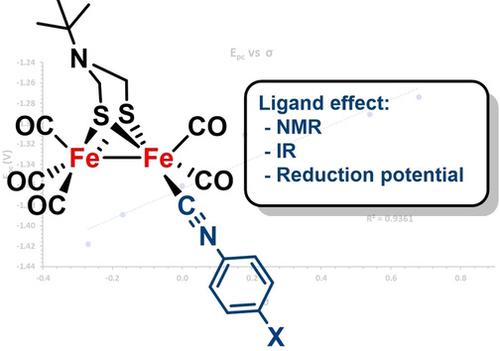当前位置:
X-MOL 学术
›
ChemistrySelect
›
论文详情
Our official English website, www.x-mol.net, welcomes your
feedback! (Note: you will need to create a separate account there.)
A Model for the Prediction of the Redox Potentials in [FeFe]‐Clusters from the Electronic Properties of Isocyanide Ligands
ChemistrySelect ( IF 1.9 ) Pub Date : 2020-06-24 , DOI: 10.1002/slct.202001820 Alba Collado 1 , Alejandro Torres 1 , Mar Gómez‐Gallego 1 , Luis Casarrubios 1 , Miguel A. Sierra 1
ChemistrySelect ( IF 1.9 ) Pub Date : 2020-06-24 , DOI: 10.1002/slct.202001820 Alba Collado 1 , Alejandro Torres 1 , Mar Gómez‐Gallego 1 , Luis Casarrubios 1 , Miguel A. Sierra 1
Affiliation

|
Using an experimental‐computational methodology, arylisocyanides (CNAr) have shown to be excellent probes to study the effect of electronic properties in the electrochemical behavior of [FeFe]‐complexes. The calculated LUMO distribution of p‐ substituted [Fe2{(μ‐SCH2)2N t Bu}(CO)5(CNAr)] complexes (2 ) show that, depending on the substituent, the first reduction event (Epc ) may be metal centered or ligand centered. The electrochemical response of complexes 2 has been experimentally studied and correlated to the calculations performed. The Epc values were found to directly correlate to different spectroscopic properties such as IR and 13C{1H} NMR spectroscopies. These findings could be used to predict the Epc values of new [FeFe]‐complexes.
中文翻译:

从异氰化物配体的电子特性预测[FeFe]-簇中氧化还原电势的模型
使用实验计算方法,芳基异氰化物(CNAr)已证明是研究电子性质对[FeFe]复合物电化学行为影响的极佳探针。的所计算的LUMO分布对-取代的[Fe 2 {(μ-SCH 2)2 Ñ吨卜}(CO)5(CNAR)]配合物(2)表明,这取决于取代基,第一减速事件(Ë PC )可以以金属为中心或以配体为中心。对配合物2的电化学响应进行了实验研究,并与进行的计算相关。该Ë PC 发现这些值直接与不同的光谱性质相关,例如IR和13 C { 1 H} NMR光谱。这些发现可用于预测新的[FeFe]复合物的E pc 值。
更新日期:2020-06-24
中文翻译:

从异氰化物配体的电子特性预测[FeFe]-簇中氧化还原电势的模型
使用实验计算方法,芳基异氰化物(CNAr)已证明是研究电子性质对[FeFe]复合物电化学行为影响的极佳探针。的所计算的LUMO分布对-取代的[Fe 2 {(μ-SCH 2)2 Ñ吨卜}(CO)5(CNAR)]配合物(2)表明,这取决于取代基,第一减速事件(Ë PC )可以以金属为中心或以配体为中心。对配合物2的电化学响应进行了实验研究,并与进行的计算相关。该Ë PC 发现这些值直接与不同的光谱性质相关,例如IR和13 C { 1 H} NMR光谱。这些发现可用于预测新的[FeFe]复合物的E pc 值。











































 京公网安备 11010802027423号
京公网安备 11010802027423号